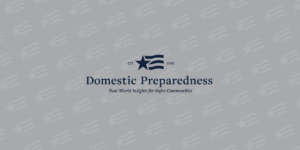

The Dynamics of Human Trafficking: Before & After COVID-19
Michael Breslin
June 24, 2020
These are challenging times. The immediate impacts of the coronavirus pandemic are impossible to ignore when viewed in terms of the sickness and death it has brought upon the world community. It continues to impact the global economy and social norms. The long-term impacts of this virus and subsequent mitigation efforts may not be completely understood for quite some time. What is known is the pandemic has impacted almost every aspect of daily life, from social distancing rules, interrupted supply chains, longer waits at the supermarket, school closures, cancelled milestones, record unemployment, remote learning, and telework to the closure of places of worship. The COVID-19 pandemic has been a transformative event.

Whole Community – Threats & Solutions
Catherine L. Feinman
June 24, 2020
The concept of a whole community approach has been recommended for years. However, it has perhaps
not been more important than it is today. Compounding events, or disasters within disasters, are why
emergency planners stress the importance of planning for the worst but hoping for the best. Well, the
time to implement these plans is now. The ongoing COVID-19 pandemic does not appear to be ending anytime
soon. However, life must go on. “Normal” seasonal disasters like wildfires, hurricanes, earthquakes, and
floods will not wait for communities to replenish supplies, reallocate resources, and hire more staff.
Human-caused threats may escalate as bad actors take advantage of physical and technological
vulnerabilities that the pandemic exposes. The common primary, secondary, and tertiary effects of
smaller threats worsen when compounded with the pandemic response.

An All-Hazards Educational Approach to Emergency Management
Paula Gordon
June 17, 2020
The nature and scope of the emergency management field can be defined in a variety of ways. An all-hazards definition of emergency management encompasses some essential homeland security concerns. A conceptual framework then helps bring together an understanding of the challenges facing those in the emergency management and homeland security fields when an all-hazards definition of emergency management is used.

Active Shooter Preparedness: Beyond Run/Hide/Fight
Chad Hyland
June 10, 2020
Run/Hide/Fight or Avoid/Deny/Defend – no matter which mantra is taught/trained, there is one
unfortunate constant between both methodologies: the shooting has begun, and there is an imminent loss
of life occurring at the workplace, school, church, grocery store, or wherever the active shooters have
selected their targets. Thorough understanding of these methodologies is certainly important during an
active shooter event. Often, bystanders freeze in disbelief that the incident is happening to them. This
is not the common fight versus flight response. There is initial shock to the system. Repetition through
training and exercises will create that imbedded response in the cerebellum to create the muscle memory
needed for all bystanders to react and Run/Hide/Fight or Avoid/Deny/Defend. Not to dissuade from
bolstering preparedness through this training, the fact remains that lives are being threatened when the
response is initiated. A true active shooter preparedness plan needs to go beyond the Run/Hide/Fight or
Avoid/Deny/Defend reaction.

Acceptable Loss in a Pandemic-Editor’s Note
Martin D. Masiuk
June 4, 2020
Dear DomPrep Readers,Since day one on 11 November 1998, DomPrep has been and continues to be a publication for preparedness and resilience professionals with operational and strategic responsibilities. Since then,

National Pandemic Planning – The Forgotten Scenarios
Rick C. Mathews
June 3, 2020
“Are we prepared?” is a simple question with a not-so-simple answer. There are generally two times this question arises: (1) when funding is being requested, and (2) after an incident occurs where the preparedness comes under review. Both timings are appropriate, but arguably not the best time to raise the question. The best time to ask this question is that “sweet spot” between a request for funding and an actual need arises. However, this ideal time is frequently missed or avoided. Some would say it is human nature to avoid tough questions unless forced to face them; other times, it is because of the preparedness issue conflicting with other priorities that comprise the agendas of most agencies, governments, and private sector managers.

